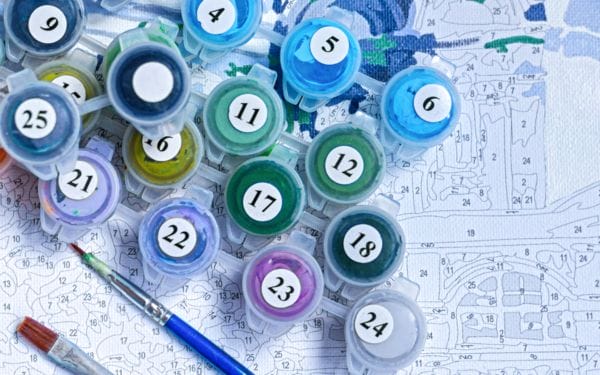September 6, 2021
By Aleta Margolis, Founder and President, Center for Inspired Teaching
Hooray for Monday is a weekly blog filled with questions, ideas, reflections, and actions we can all take to remodel the school experience for students.

I have fond childhood memories of sitting at the kitchen table, skinny paintbrush in hand, with tiny connected plastic cups of oil paint, each with a number on the top, spread across the table. In front of me were white sheets of cardstock covered in black, curvy lines – each of which would reveal a mystery picture once the colors were filled in.
I loved the feeling of putting the first bit of paint on the paper. I generally began with the 1s before moving on to the 2s, 3s, and beyond. Occasionally, if I were feeling rebellious, I’d start with a random number, say 7, and then work backward to 1, before heading up to 8, 9, 10, and beyond.
The most satisfying part always came at the end when, no matter what order I’d painted in, I had before me a perfectly colored and shaded peacock or bouquet of sunflowers or pirate standing over a treasure chest.
Recently I saw an ad on my phone for a paint-by-numbers app. It had over 2 million reviews, with a 4.8-star rating.
Looks like we still love to paint by numbers as much as I did when I was a child.

Painting by numbers feels good. That’s because a positive outcome is guaranteed. All we have to do is follow the numbers as written and we are guaranteed a perfectly proportioned, lifelike painting at the end. Some outside experts figured out the design for the sketch, and the “best” colors to use to show light and shadow. Someone even figured out how much we’d need of each paint color – and did us the favor of putting each one in a convenient little plastic cup!
Because the product is predetermined, there’s no risk. We can relax into the painting process knowing the outcome is already known. When we paint by numbers, we don’t experience stress or responsibility for the outcome. This is what makes paint-by-numbers such a relaxing activity to do in our downtime.
As we start this challenging school year when so much is uncertain, it would be comforting to know exactly where we’re headed, and what the results of our efforts will look like, down to the very last detail. There are certain situations where we are wise to establish policies and follow directions to the letter; rules that preserve our health and safety, such as mask-wearing or Covid testing are obvious examples.
But when we are striving to teach our students the skills and knowledge they’ll need for life beyond the classroom, we have to take a different approach.
While painting by numbers offers a great moment of escape, it doesn’t do much to prepare us to be artists (fine motor skills aside). What is the corollary in the classroom? Much of the curriculum we are expected to use to teach our students contains lessons that follow a paint-by-numbers structure where the best possible outcome is for all students to arrive at the same predetermined destination. But no two people emerge from their preK-12 school experience destined for the same adult life.
So, how can we build our students’ ability to think and figure things out for themselves? To create when there’s no roadmap? To solve problems when there’s no outside expert preparing the plan, putting the paint in prepackaged, pre-measured containers?
What about…
-
Inviting students to help design the space in the classroom and hallways?
-
Collaborating with students to analyze the posters in their classroom, or even schoolwide, for implicit and explicit messages?
-
Asking students to create a plan for traveling respectfully through the hallways, instead of telling them how to do it?
-
Sharing the things we are passionate about with our students, asking them what they’ve always wanted to learn – then incorporating their interests into our curriculum?
Paint-by-numbers is lovely as a stress relief game and it’s worth doing, to rest our minds. But real life is a lot more like an enormous blank canvas. As teachers, we have the opportunity to inspire our students with the confidence and curiosity to stretch beyond what’s easy and fill that canvas with the brush strokes, colors, and content that are uniquely their own.
